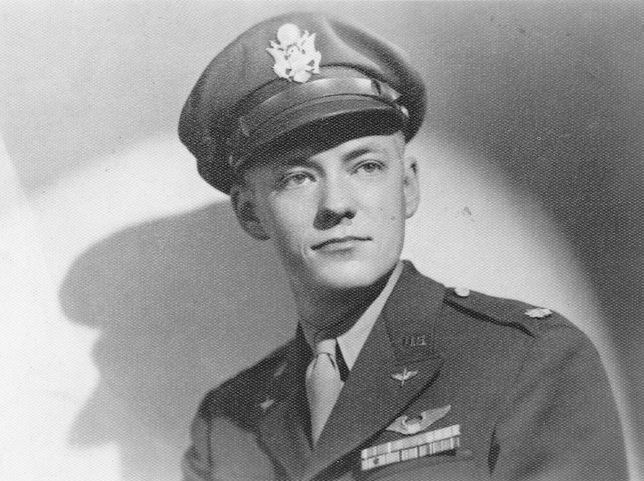Smith, Robert Eugene "Gene"
- Date of birth:
- February 26th, 1917 (Wichita-Sedgwick County/Kansas, United States)
- Date of death:
- June 22nd, 1944 (Normandy, France)
- Buried on:
- Normandy American Cemetery and Memorial
Plot: C. Row: 6. Grave: 40. - Nationality:
- American
Biography
Robert Eugene Smith was born on 26th February 1917 as son of Myrtle and Arthur Orville Smith with two brothers Paul and Dale. The family moved to Cincinnati to be closer to his half sister Mabel and her family who at that time lived in Columbus. Myrtle and Arthur Orville bought a farm on Colerain Avenue and the boys went to White Oak High School. When it came time for university the parents could not afford to put two sons through college, so Robert Eugene entered Ohio State through the R.O.T.C. program. He played the clarinet in the Ohio State marching band and studied engineering. He lived with Mabel and her family in Columbus to help him with food and some spending money. He was like a big brother to his three adoring nieces whom he babysat. Before World War II he went into the Army Air Force to pay back for his studies.
At one time during World War II all three brothers were active in different branches of the service. Gene was not a Flying Tiger as they were already disbanded, but he flew with some of the original Flying Tigers and was under the command of General Claire Chennault. Gene was one of the most successful pilots in the early days of the 16th Fighter Squadron, 23 Fighter Group. His P-40E-1 "White 30" carried the name KatyDid on its nose. He literally saw the world traveling to China, Africa and India. He told the family that his most moving experience was flying over the Taj Mahal lit up at night with lights. While in China his group dined with General Chiang Kai Shek and his wife who at that time were allies of Roosevelt. On missions he did fly the tiger-nosed planes and became an Ace pilot while flying in China. During one mission his plane went down near a small village. The villagers not knowing who or what he was started to come after him. He had a small American flag that he waived letting him know that he was an American and on their side. During a short time in California, he met a lady named Catherine McDowell who became his wife and the mother of his only child, a girl named Diane.
In the spring of 1944 he was with the 394th Fighter Squadron, 367th Fighter Group in England. Before going to England he returned for a short visit to Cincinnati where his parents and sister Mabel's family now lived. The family took him to Lunken Airport where he told his brother in law Joe, "If I don't come back, don't grieve me. I have lived the life that few men do". The operational tempo in Europe was further increased following D-Day with Gene claiming a BF 109 damaged on June 17th. Five days later he was killed when his P-38 J 42-104316 was shot down by flak near Cherbourg in France during yet another strafing mission. Before crashing he radioed in to his next in command saying, "I've been shot, I'm going down and you are in command". His plane's nose floated onto the beach of Normandy with his body inside. The middle of three stars that hung in the front windows of his mother and sister's homes became gold and his mother chose to leave him in France to be buried. Gene did not know it, but he had already been promoted to Major and the paperwork had already been approved. Although the promotion was posthumous, he was at that time the youngest ever to hold that rank.
Victories:
16th Fighter Squadron:
9th November 1942 (1st Lieutenant): China-Birma-India Theatre;
16th January 1943 (Captain): China-Birma-India Theatre;
16th January 1943 (Captain): China-Birma-India Theatre;
8th May 1943 (Captain): China-Birma-India Theatre;
Do you have more information about this person? Inform us!
- Period:
- Second World War (1939-1945)
- Period:
- Second World War (1939-1945)
- Period:
- Second World War (1939-1945)
Second Air Medal awarded as a bronze oak leaf cluster to be worn on the ribbon of the first Air Medal.
- Period:
- Second World War (1939-1945)
Third Air Medal awarded as a second bronze oak leaf cluster to be worn on the ribbon of the first Air Medal.
- Period:
- Second World War (1939-1945)
- Rank:
- Major
- Unit:
- 394th Fighter Squadron, 367th Fighter Group, U.S. Army Air Forces
Awarded posthumously.
- Period:
- Second World War (1939-1945)
- Period:
- Second World War (1939-1945)
- Unit:
- 16th Fighter Squadron, 23rd Fighter Group, U.S. Army Air Forces
Received with one campaign star.
- Period:
- Second World War (1939-1945)
- Period:
- Second World War (1939-1945)
Sources
- Photo 1: Pam Sattari
- - Find a Grave
- American Battle Monuments Commission
- Ciel de Gloire
- Family Records









